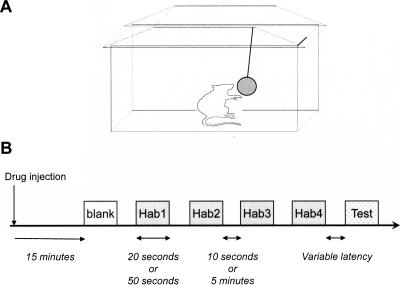Figure 1.
Experimental design. (A) Mice were separated into individual plastic cages with microisolator tops. For each trial, the cage was opened and a tea ball containing an odor source was hung within the cage so that the mouse could easily investigate it. The disturbance of placing the tea ball into the cage initiated each trial. (B) Habituation paradigms consisted of six trials: one blank trial in which clean bedding or plain mineral oil was presented to prehabituate mice to the non-olfactory features of stimulus presentation (these data are omitted from data figures and statistical analyses), four habituation trials in which soiled bedding or diluted acetic acid were presented as odorants, and, in some experiments, one test trial in which the habituation odorant or a structurally similar odorant was presented. In pharmacological experiments, the blank trial always began 15 min following drug injection. Two timescales of odorant presentation were used: either short (20-sec presentations with 10-sec ITIs) or long (50-sec presentations with 5-min ITIs). For memory persistence experiments, the ITI between the last habituation trial and the test trial (latency) was the variable of interest and hence an exception to this rule. Soiled bedding from an isolated male conspecific was used as both the habituation and test odor except in memory specificity experiments, in which the habituation odorant was acetic acid and the test odorant was one of four structurally and perceptually similar odorants (propanoic, butanoic, pentanoic, or hexanoic acid).

